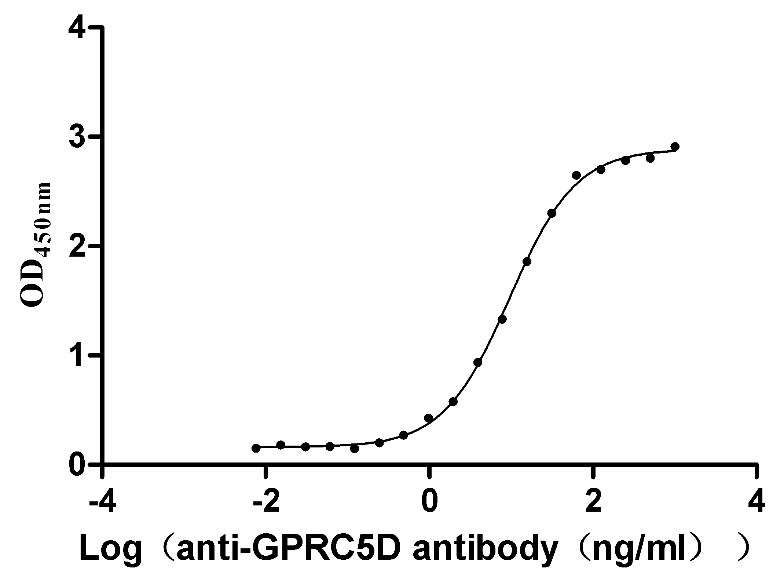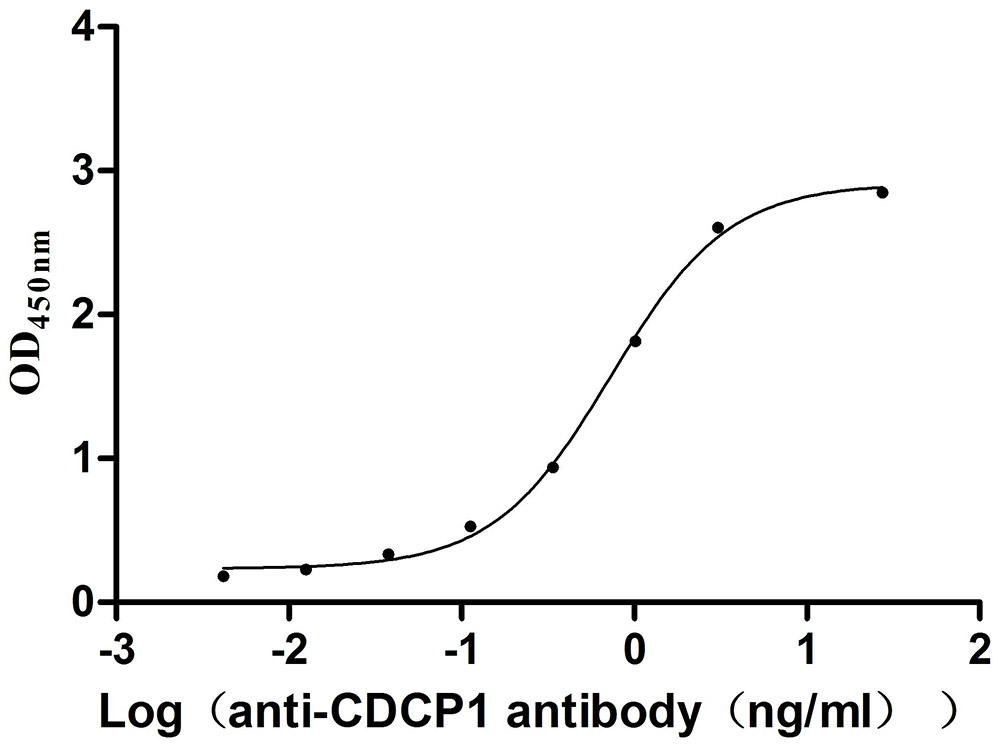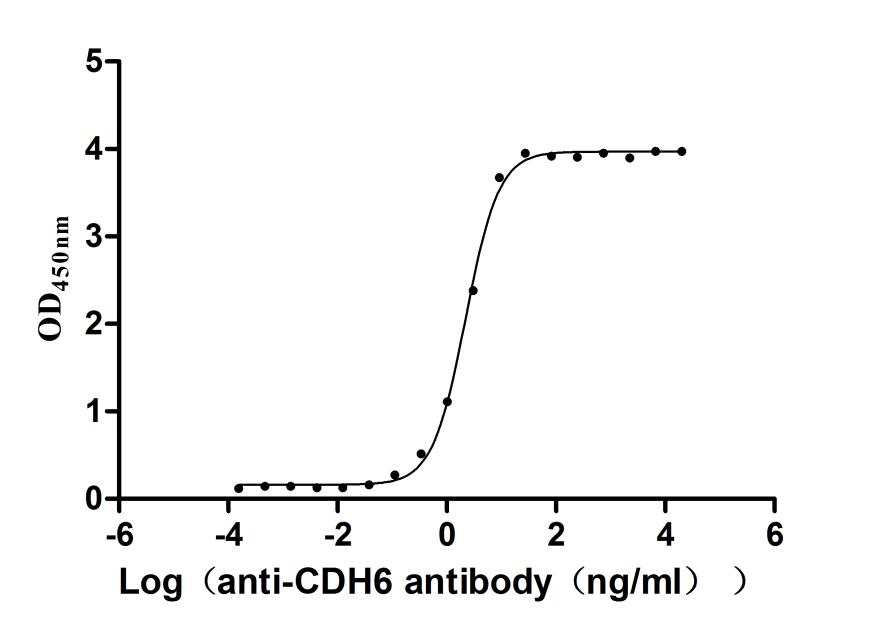Recombinant Human N-alpha-acetyltransferase 10 (NAA10)
-
货号:CSB-YP001984HU
-
规格:
-
来源:Yeast
-
其他:
-
货号:CSB-EP001984HU
-
规格:
-
来源:E.coli
-
其他:
-
货号:CSB-EP001984HU-B
-
规格:
-
来源:E.coli
-
共轭:Avi-tag Biotinylated
E. coli biotin ligase (BirA) is highly specific in covalently attaching biotin to the 15 amino acid AviTag peptide. This recombinant protein was biotinylated in vivo by AviTag-BirA technology, which method is BriA catalyzes amide linkage between the biotin and the specific lysine of the AviTag.
-
其他:
-
货号:CSB-BP001984HU
-
规格:
-
来源:Baculovirus
-
其他:
-
货号:CSB-MP001984HU
-
规格:
-
来源:Mammalian cell
-
其他:
产品详情
-
纯度:>85% (SDS-PAGE)
-
基因名:NAA10
-
Uniprot No.:
-
别名:Alpha N acetyltransferase 1A; ARD1; ARD1 homolog N acetyltransferase (S. cerevisiae); ARD1 homolog A N acetyltransferase (S. cerevisiae); ARD1 homolog A N acetyltransferase; ARD1A; DXS707; MGC71248; N acetyltransferase ARD1, human homolog of; N alpha acetyltransferase 10 NatA catalytic subunit; N terminal acetyltransferase complex ARD1 subunit homolog A; N(alpha) acetyltransferase 10 NatA catalytic subunit; N-alpha-acetyltransferase 10; N-terminal acetyltransferase complex ARD1 subunit homolog A; Naa10; NAA10_HUMAN; NatA catalytic subunit; TE2
-
种属:Homo sapiens (Human)
-
蛋白长度:Full length protein
-
表达区域:1-235
-
氨基酸序列MNIRNARPED LMNMQHCNLL CLPENYQMKY YFYHGLSWPQ LSYIAEDENG KIVGYVLAKM EEDPDDVPHG HITSLAVKRS HRRLGLAQKL MDQASRAMIE NFNAKYVSLH VRKSNRAALH LYSNTLNFQI SEVEPKYYAD GEDAYAMKRD LTQMADELRR HLELKEKGRH VVLGAIENKV ESKGNSPPSS GEACREEKGL AAEDSGGDSK DLSEVSETTE STDVKDSSEA SDSAS
-
蛋白标签:Tag type will be determined during the manufacturing process.
The tag type will be determined during production process. If you have specified tag type, please tell us and we will develop the specified tag preferentially. -
产品提供形式:Lyophilized powder
Note: We will preferentially ship the format that we have in stock, however, if you have any special requirement for the format, please remark your requirement when placing the order, we will prepare according to your demand. -
复溶:We recommend that this vial be briefly centrifuged prior to opening to bring the contents to the bottom. Please reconstitute protein in deionized sterile water to a concentration of 0.1-1.0 mg/mL.We recommend to add 5-50% of glycerol (final concentration) and aliquot for long-term storage at -20℃/-80℃. Our default final concentration of glycerol is 50%. Customers could use it as reference.
-
储存条件:Store at -20°C/-80°C upon receipt, aliquoting is necessary for mutiple use. Avoid repeated freeze-thaw cycles.
-
保质期:The shelf life is related to many factors, storage state, buffer ingredients, storage temperature and the stability of the protein itself.
Generally, the shelf life of liquid form is 6 months at -20°C/-80°C. The shelf life of lyophilized form is 12 months at -20°C/-80°C. -
货期:Delivery time may differ from different purchasing way or location, please kindly consult your local distributors for specific delivery time.Note: All of our proteins are default shipped with normal blue ice packs, if you request to ship with dry ice, please communicate with us in advance and extra fees will be charged.
-
注意事项:Repeated freezing and thawing is not recommended. Store working aliquots at 4°C for up to one week.
-
Datasheet :Please contact us to get it.
相关产品
靶点详情
-
功能:Catalytic subunit of N-terminal acetyltransferase complexes which display alpha (N-terminal) acetyltransferase activity. Acetylates amino termini that are devoid of initiator methionine. The alpha (N-terminal) acetyltransferase activity may be important for vascular, hematopoietic and neuronal growth and development. Without NAA15, displays epsilon (internal) acetyltransferase activity towards HIF1A, thereby promoting its degradation. Represses MYLK kinase activity by acetylation, and thus represses tumor cell migration. Acetylates, and stabilizes TSC2, thereby repressing mTOR activity and suppressing cancer development. Acetylates HSPA1A and HSPA1B at 'Lys-77' which enhances its chaperone activity and leads to preferential binding to co-chaperone HOPX. Acetylates HIST1H4A. Acts as a negative regulator of sister chromatid cohesion during mitosis.
-
基因功能参考文献:
- Since the FIH-1 dependent hydroxylation of NAA10 occurs oxygen-dependently, NAA10 acetylates HIF-1alpha under normoxia but does not under hypoxia. PMID: 30237125
- In combination with acetylation assays, the HypK N-terminal region is identified as a negative regulator of the NatA acetylation activity PMID: 28585574
- ARD1-mediated Hsp70 acetylation is a regulatory mechanism that temporally balances protein refolding/degradation in response to stress PMID: 27708256
- Negative regulation of Naa10 towards NTN1 and its receptor UNC5B were also detected upon treatment of all-trans retinoid acid, which was often used to induce morphological differentiation. PMID: 27910960
- A novel de novo NAA10 c.332 T>G p.(Val111Gly) missense variant was detected in a girl with mild/moderate non-syndromic intellectual disability. NAA10 V111G displayed reduced monomeric NAT activity and stability, but intact NatA-mediated NAT activity. PMID: 29558889
- Expression of ARD1 increases levels of androgen receptor acetylation and androgen receptor-HSP90 dissociation in a dose dependent manner. PMID: 27659526
- Study reports on a total of 12 affected females with four different de novo missense mutations in NAA10 and one inherited mutation in a familial case due to germline mosaicism, thus further expanding themutational and clinical spectrum associated with NAA10 related N-terminal-acetyltransferase deficiency. PMID: 27094817
- our study illustrated that the expression of Naa10p had a potential value for predicting the progression of OSCC and prognosis of OSCC patients. PMID: 26662107
- The results observed an inverse correlation between the expression of NAA10 and that of miR-342-5p and miR-608 . PMID: 26646451
- Human Naa15 (NATH) and Naa10 (ARD1) form a stable NatA complex which associates with ribosomes and performs co-translational N-terminal acetylation; Naa15 (NATH) and Naa10 (ARD1) are cleaved during apoptosis resulting in decreased acetyltransferase activity PMID: 15496142
- The clinical spectrum of NAA10. PMID: 26522270
- there is no difference in lysine acetylation of substrate proteins with or without Naa10, suggesting that the substrates may be acetylated chemically rather than enzymatically. PMID: 26755727
- Combined high expression of Naa10p, SNCG and PRL-3 are associated with lymph node metastasis in breast cancer. PMID: 25854368
- De novo missense mutations in the NAA10 gene cause severe non-syndromic developmental delay in males and females PMID: 25099252
- human ARD1 variants have different effects on cell proliferation, which may result from distinct subcellular localizations and autoacetylation activities. PMID: 25421966
- Naa10 structure and function. [Review] PMID: 25987439
- Autoacetylation of ARD1 variants differentially regulates angiogenesis and cell proliferation in an isoform-specific manner. PMID: 25338643
- ARD1 has a crucial role in the cellular response to oxidative stress as a bona fide regulator of MSRA. PMID: 25341044
- Naa10p inhibits the metastasis of breast cancer cells by targeting STAT5a. PMID: 24925029
- results show that hARD1 nuclear translocation mediated by NLS is required for cell cycle progression, thereby contributing to proper cell proliferation. PMID: 25133627
- Study describes a Saccharomyces cerevisiae model developed by introducing the human wild-type (wt) or mutant NatA complex into yeast lacking NatA (NatA-Delta). The wt human NatA complex phenotypically complemented the NatA-Delta strain, whereas only a partial rescue was observed for the Ogden mutant NatA complex suggesting that hNaa10 S37P is only partially functional in vivo. PMID: 24408909
- The study concludes that the NAA10 mutation is the cause of Lenz microphthalmia syndrome in a family, likely through the dysregulation of the retinoic acid signalling pathway. PMID: 24431331
- Protein N-terminal acetyltransferases (NATs), including Naa10, act as N-terminal propionyltransferases. PMID: 23043182
- Development of the first specific NAT-inhibitors, including inhibitors targeting Naa10. PMID: 23557624
- Structural characterization of native hARD1 using size exclusion chromatography, circular dichroism, & fluorescence spectroscopy shows the protein consists of compact globular region comprising 2 thirds of the protein & a flexible unstructured C terminus. PMID: 16823041
- ARD1 functions as an inhibitor of the mTOR pathway and that dysregulation of the ARD1-TSC2-mTOR axis may contribute to cancer development PMID: 20145209
- These results indicate that ARD1A is a novel tumor-associated antigen and a potential prognostic factor for colon cancer. PMID: 20639454
- The expression level of NAA10 is inversely correlated with that of MMP-9 in breast cancer samples. PMID: 23550278
- Naa10p suppresses 28S proteasome activity through interaction with PA28beta. PMID: 23624078
- These data indicate that the interaction between ARD1 and RIP1 plays an important role in the DNA damage-induced NF-kappaB activation, and that the acetyltransferase activity of ARD1 and its localization in to the nucleus are involved in such stress response. PMID: 22580278
- study revealed a novel mechanism controlling MCL1 expression, in which Naa10p and RelA/p65 synergistically interact with MCL1 promoter region and promote MCL1 transcription PMID: 22496479
- Arrest-defective protein 1 homolog A (ARD1) in combination with SNCG/Hiwi/PRL-3 may lead to a poor outcome in patients with or without lymph node metastatic colon cancer. PMID: 22261620
- ARD1 functions as a unique AR regulator in prostate cancer cells. PMID: 22315407
- A reduction in acetylation by hNaa10p causes lethal X-linked disorder of infancy. PMID: 21700266
- N(alpha)-acetyltransferase 10 may function as a post-translational actin N(alpha)-acetyltransferase. PMID: 21383206
- suggest that Naa10p functions as a tumor metastasis suppressor by disrupting the migratory complex, PIX-GIT- Paxillin, in cancer cells PMID: 21295525
- interaction between hNaa10p and DNMT1 was required for E-cadherin silencing through promoter CpG methylation, and E-cadherin repression contributed to the oncogenic effects of hNaa10p. PMID: 20592467
- Results show that hARD1 autoacetylation is critical for its activation and its ability to stimulate cancer cell proliferation and tumorigenesis. PMID: 20501853
- Data indicate that the physical interaction between HYPK and NatA Naa10/15 seems to be of functional importance both for huntingtin aggregation and for N-terminal acetylation. PMID: 20154145
- hARD1 is a bona fide regulator of MLCK, and hARD1 plays a crucial role in the balance between tumor cell migration and stasis PMID: 19826488
- ARD1-mediated acetylation regulates and destabilizes HIF-1 alpha by directly binding to it. PMID: 12464182
- description of the human homologue of Nat1p, NATH (NAT human), as the binding partner of the hARD1 (human ARD1) protein PMID: 15496142
- Amino-terminal acetyltransferase ARD1 (hARD1) interacts with a novel motif, 658-HGVVEVD-664, in the cytoplasmic domain of beta-amyloid precursor protein. PMID: 15749829
- ARD1 is involved in cell proliferation and in regulating a series of cellular metabolic pathways that are regulated during hypoxia response. PMID: 15755738
- Data demonstrate that ARD1 has limited, if any, impact on the HIF-1alpha signaling pathway. PMID: 15994306
- levels of endogenous NATH and hARD1 proteins in thyroid papillary carcinoma patients; results suggest that NATH positively affects the level of hARD1 protein both in vivo and in cell cultures PMID: 16279846
- ARD1 specifically binds HIF-1 alpha, suggesting a putative, still unclear, connection between these proteins. PMID: 16288748
- A human ARD1 variant ortholog (235) has weak effects on hypoxia inducible factor (HIF)-1 alpha and VEGF mRNA stability compared to mouse ARD1 ortholog 225. PMID: 16376303
- Essential role in cell survival through protein N-alpha-acetylation. PMID: 16518407
- These results indicate that ARD1(235) and ARD1(225) isoforms may have different activities and function in different subcellular compartments of mammalian cells. PMID: 17161380
显示更多
收起更多
-
相关疾病:N-terminal acetyltransferase deficiency (NATD); Microphthalmia, syndromic, 1 (MCOPS1)
-
亚细胞定位:Cytoplasm. Nucleus.
-
蛋白家族:Acetyltransferase family, ARD1 subfamily
-
组织特异性:Ubiquitous.
-
数据库链接:
HGNC: 18704
OMIM: 300013
KEGG: hsa:8260
STRING: 9606.ENSP00000417763
UniGene: Hs.433291
Most popular with customers
-
Recombinant Human T-cell surface protein tactile (CD96), partial (Active)
Express system: Mammalian cell
Species: Homo sapiens (Human)
-
Recombinant Human G-protein coupled receptor family C group 5 member D (GPRC5D)-VLPs (Active)
Express system: Mammalian cell
Species: Homo sapiens (Human)
-
Recombinant Human Glucagon-like peptide 1 receptor (GLP1R), partial (Active)
Express system: Mammalian cell
Species: Homo sapiens (Human)
-
Recombinant Human Cell adhesion molecule 1 (CADM1), partial (Active)
Express system: Mammalian cell
Species: Homo sapiens (Human)
-
Recombinant Mouse CUB domain-containing protein 1 (Cdcp1), partial (Active)
Express system: Mammalian cell
Species: Mus musculus (Mouse)
-
Recombinant Human B- and T-lymphocyte attenuator(BTLA), partial (Active)
Express system: Mammalian cell
Species: Homo sapiens (Human)
-
Recombinant Macaca fascicularis Cadherin 6(CDH6),partial (Active)
Express system: Mammalian cell
Species: Macaca fascicularis (Crab-eating macaque) (Cynomolgus monkey)


-AC1.jpg)
















